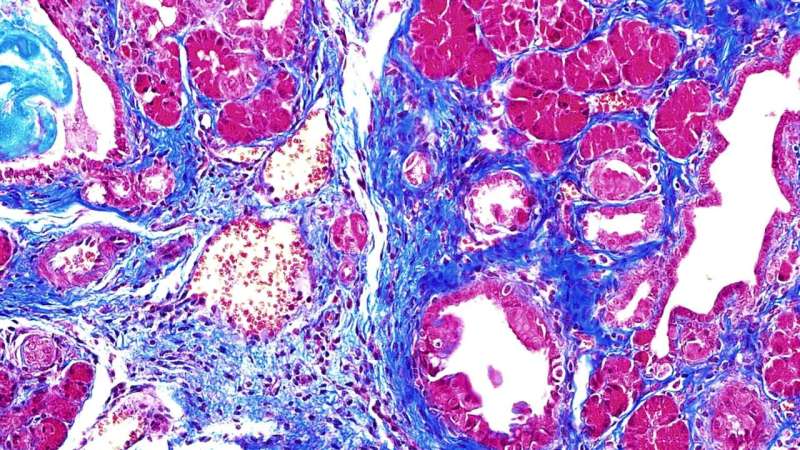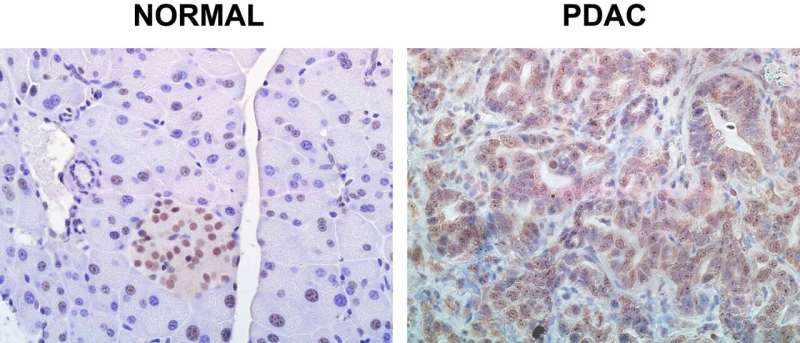This article has been reviewed according to Science X's editorial process and policies. Editors have highlighted the following attributes while ensuring the content's credibility:
fact-checked
peer-reviewed publication
trusted source
proofread
Examining a protein that contributes to pancreatic cancer

Pancreatic ductal adenocarcinoma (PDAC) is the most common form of pancreatic cancer. It's also one of the deadliest. More than 90% of PDAC patients die within five years of diagnosis. Usually, by the time the cancer is identified, it has already spread.
"PDAC is often found too late for treatments like chemotherapy and surgery to be very effective," Cold Spring Harbor Laboratory (CSHL) Professor Adrian Krainer says. "But if we can clearly understand the underlying genetic mechanisms of PDAC, this might lead to earlier diagnoses and new types of therapies."
Krainer and CSHL Postdoc Ledong Wan partnered with CSHL Professor David Tuveson to explore the role of a genetic process called RNA splicing in pancreatic cancer. RNA splicing helps DNA deliver instructions to cells for protein production. The team zeroed in on a splicing-regulator protein called SRSF1. They found that high levels of SRSF1 cause inflammation, or pancreatitis. This jumpstarts PDAC tumor development.
"Cells have several processes to keep SRSF1 levels constant," says Krainer. "But cancer tends to find a way to overcome these checks and balances."
Several genes, RNAs, and proteins work together in cells to keep SRSF1 levels steady. But sometimes, the process gets disrupted. In the pancreas, this triggers pancreatitis and accelerates PDAC.

"It's a very pronounced effect," Krainer explains. "We could see that patients whose tumors express higher levels of SRSF1 have worse outcomes. So, we set out to explore to what extent SRSF1 contributes to PDAC."
The team found that higher levels of SRSF1 are essential for PDAC growth in mice and organoids—small versions of tumors. Furthermore, when SRSF1 returned to normal levels, the organoids stopped growing. SRSF1 is important in healthy tissue, so it may not be an ideal drug target by itself. However, some of the splicing changes it promotes could be targeted instead. Krainer says there is still more work to be done.
"We're excited by these developments," he says. "But PDAC is a difficult and complicated malignancy. We're hoping to provide actionable information for future treatments. This work spearheaded by Ledong is just the tip of the iceberg."
Krainer and Wan's collaboration with the Tuveson lab is part of a broader effort to explore pancreas and breast cancer. The initiative also includes CSHL Professors David Spector and Christopher Vakoc.
"The Krainer lab's paradigm-shifting work has led to a deeper understanding of many types of cancer," says Tuveson, director of the CSHL Cancer Center. "Dr. Wan's research reveals an exciting new avenue to understand pancreatic cancer. It reaffirms the importance of basic biological research for the improvement of human health."
The research was published in Cancer Discovery.
More information: Splicing Factor SRSF1 Promotes Pancreatitis and KRASG12D-Mediated Pancreatic Cancer, Cancer Discovery (2023). DOI: 10.1158/2159-8290.CD-22-1013


















